Durst F. Fluid Mechanics: An Introduction to the Theory of Fluid Flows
Подождите немного. Документ загружается.

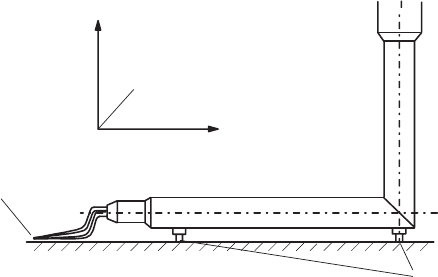
21.5 Basics of Hot-Wire Anemometry 675
By addition and subtraction it is possible, as the above equations show, to
determine the instantaneous U and W components of the velocity field.
In practice, it is also usual to employ three-wire probes, in order to measure
all three velocity components simultaneously. At this point, we only want to
mention this fact. It is the object of this section of the book, to give an
introduction to flow-measurement technology and for this purpose the above
references to a few hot-wire probe geometries suffice.
For boundary-layer investigations, it is extremely important to carry out
measurements close to walls. For such investigations probes with wire holders
are employed, which are formed in such a way that they permit measure-
ments near to the walls. Such a probe with specially formed prongs is shown
in Fig. 21.22. It is oriented such that the u component of the fluid is mea-
sured. Traversing takes place in the y direction, to obtain the U velocity
profile.
Different demands are placed on the geometry of the hot-wire probes.
In order to keep the inevitable introduction of disturbances into the flow
by hot-wire probes low and to obtain a good spatial resolution and a high
vibration resistivity of the probe, the probes should, on the one hand, have
probe lengths as short as possible. On the other hand, in order to reduce
the disturbing influence of the prongs, a large distance between the prongs
would be required. Small wire diameters are required for high resolution in
terms of time and space. Large diameters, on the other hand, ensure high
mechanical strength and smaller wire strains when mechanically stressed. By
compromising, nowadays optimized probes are available which permit reliable
measurements by means of hot-wire anemometers.
U
1
= U
U
2
= V
x
y
Spacer
Hot-wire lies
parallel to wall
Origin of
coordinate system
Fig. 21.22 Probe for boundary-layer investigations with special prong arrangement
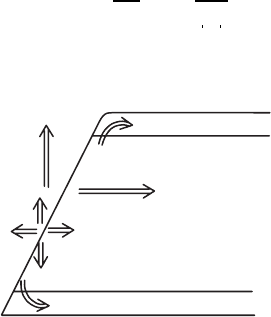
676 21 Introduction to Fluid-Flow Measurement
21.5.4 Cooling Laws for Hot-Wire Probes
The basis for determining the flow velocity by means of hot-wire probes,
is the heat transfer from the heated sensor to the medium flowing around
the sensor. The heat can be transferred from the sensor by radiation
˙
Q
R
,
conduction
˙
Q
C
,freeconvection
˙
Q
FC
, and especially by forced convection
˙
Q
con
(Fig. 21.23).
In the thermal equilibrium state, the supplied electric power is
˙
Q
el
= IE = I
2
R = E
2
/R (21.9)
equal to the heat output carried off by the sensor:
I
2
R =
˙
Q
R
+
˙
Q
C
+
˙
Q
FC
+
˙
Q
con
(21.10)
The radiant heat
˙
Q
RSt
can be computed according to the equation:
˙
Q
R
= kσA
!
T
4
− T
4
m
"
, (21.11)
where σ is the Stefan–Boltzmann constant, A the heat-radiating surface of
the sensor, T is the operating temperature and T
m
the temperature of the
flow medium. The factor k is at around 0.1 and takes into account that the
radiation of hot wires amounts to about 10%, at the very most, of the radi-
ation that a black body of equal dimensions would have. Except for extreme
cases, the heat loss of hot wires due to radiation can be neglected, as it is
only a small percentage of the heat which is transferred from the sensor by
forced convection.
The heat conduction
˙
Q
C
from the hot sensor into the cold prongs is,
according to Fourier:
˙
Q
C
= −2λ
D
dT
dx
πd
2
4
end of sensor
, (21.12)
Q
F
C
Q
C
Q
con
Q
R
Q
C
•
•
•
•
•
Free convection
= Heat conduction
=
Heat conduction
= Heat radiation
= Forced convection
Prong B
Prong A
Fig. 21.23 Heat balance at the sensor in general form

21.5 Basics of Hot-Wire Anemometry 677
where λ
D
is the heat conductivity of the wire, d thewirediameteranddT/dx
the temperature gradient. The factor 2 before λ
D
, is present because of the
two prongs needed to hold the wire. For computing
˙
Q
C
, it is necessary to know
the temperature gradient at the wire ends. The temperature variation along
the sensor depends implicitly on the dimensionless heat-transfer coefficient
expressed by the Nusselt number (Nu). With hot-wire probes, the heat loss
˙
Q
C
, the so-called wire end loss to the prong, amounts to about 10–20% of the
total heat loss from the sensor. Seen relatively, this proportion is the larger
the smaller is the ratio of wire length to wire diameter.
The heat carried off from the sensor, due to free convection
˙
Q
FC
, gains in
importance when the buoyancy forces acting on the fluid flow considerably
influence the flow field around the wire. The characteristic dimensionless
quantity, which allows one to describe this influence, is the Grashof number:
Gr =
gβ∆TL
3
ν
, (21.13)
where g is the gravitation acceleration, β is the compressibility coefficient, ν
is the kinetic viscosity and ∆T is the wire overheating temperature.
According to Collis and Williams (1959), free convection can be neglected
in the case when
Re > Gr
1/3
(21.14)
The Grashof number, e.g. for a hot wire of 2.5 µm diameter in an air stream
at 300 K is about 6 ×10
−7
; therefore, for Reynolds numbers larger than 0.01,
no considerable free convection effects on the heat transfer of a hot wire are
to be expected. This means that for the usually employed hot wires in air,
free convection can be neglected at flow velocities larger than 0.1 m s
−1
.
In the case of velocity measurements with hot wires, the dominating heat-
transfer component from the wire to the flow medium surrounding it, takes
place by forced convection
˙
Q
con
. The latter can be calculated as follows:
˙
Q
con
= απld(T − T
m
), (21.15)
where T is the wire temperature, d =2r is the wire diameter, l is the wire
length, T
m
is the fluid temperature and α is the heat-transfer coefficient. It
can be computed with the help of the Fourier law:
˙
Q
Zk
= −λl
2π
#
0
∂T
∂r
r=R
R dϕ, (21.16)
where λ is the heat conduction of the fluid.
The dimensionless heat-transfer coefficient at the sensor is defined as
Nu =
αd
λ
(Nusselt number) (21.17)

678 21 Introduction to Fluid-Flow Measurement
From the above two equations, the heat transfer by convection
˙
Q
con
can be
computed as
˙
Q
con
= Nuπlλ(T − T
m
) (21.18)
Thus a simplified energy balance at the hot-wire sensor reads
E
2
R
=2λA
dT
dx
wire end
+ Nuπlλ(T − T
m
) (21.19)
For handling this equation further, a general heat-transfer law has to be for-
mulated for hot-wire probes. The similarity theory of heat transfer states that
for geometrically similar flow and heat transfer problems, the temperature
and velocity fields are similar, when the dimensionless characteristic quanti-
ties are equal. In general, the heat-transfer laws are described by relationships
between the Reynolds, Prandtl, Mach, Grashof and Knudsen numbers, of the
length-to-diameter ratio of the sensor elements, the overheating ratio, the
orientation of the probe in the flow field and other parameters.
Nu = Nu( Re, Pr, Gr, Ma, Kn, l/d, ∆T ...)
flow fluid buoyancy compress- influence geometry overheating
influence characteristics influence ability of the of the of the
influence molecule sensor hot wire
structure
For general considerations, the Nusselt number would have to be determined
individually for every flow field examined and the probe employed, in order
to formulate generally a law that takes into account the above complexity of
the dependencies.
For practical applications of hot-wire anemometry in gas flows, the flow
velocities are usually higher than 0.1 m s
−1
, and the influence of the Grashof
number on the heat transfer must therefore not be taken into account. The
same holds for the Mach number influence of the flow. When this characteris-
tic number does not exceed a certain limit, e.g. Ma ≈ 0.3, the compressibility
effects on the heat transfer can be neglected. Only in special cases, such as
in strongly diluted gases, e.g. in measurements of wind speeds at high atmo-
spheric altitudes, the diameter of the sensor can be equal to or even smaller
than the free pathlength of the molecules. In the normal case, ! (mean free
path of the molecules) d (wire diameter), i.e. the heat transfer from the
hot wires is not influenced by the Knudsen number, i.e. for all measurements
continuum mechanics is applicable.
Moreover, assuming a large length-to-diameter relation of the consid-
ered hot wire [l/d > 400], the heat transfer is two-dimensional. With these
assumptions, the “Nusselt number dependence” reads:
Nu = Nu(Re,Pr,∆T,...) (21.20)
In spite of these introduced simplifications, it is very difficult to formulate a
general law for the heat transfer by theoretical means. The heat transfer from

21.5 Basics of Hot-Wire Anemometry 679
Table 21.1 Heat-transfer laws
Reference Validity ABns
range
Collis and 0.02<Re<44 0.24 0.56 0.45 0.17 influence
Williams (1959) 0.02<Re<140 0 0.48 0.51 0.17 of the
temperature
Hilpert (1933) 1<Re<4 0 0.89 0.33 0
4<Re<40 0 0.82 0.38 0
40<Re<4,000 0 0.61 0.46 0
1<Re<4 0 0.872 0.330 0.0825 influence
4<Re<40 0 0.802 0.385 0.09625 of
40<Re<4,000 0 0.600 0.466 0.1165 the
temperature
King (1914) Pe = RePr 1
1
π
2
π
√
Pr 0.5 0 for Pr 1
Koch and Re <4.2 0.72 0.80 0.45 −0.67
Gartshore
(1972)
Kramers (1946) 0.01<Re<1,000 0.42 Pr
0.2
0.5 Pr
0.33
0.5 0
McAdams 0.1<Re<1,000 0.32 0.43 0.52 0
the hot-wire sensor is determined by the complex flow field which is developed
near the wires. Some of the heat-transfer laws, formulated and available in the
literature, are stated in Table 21.1. They are stated considering the following
form of a fitted relationship:
Nu =[A (Pr,∆T)+b (Pr,∆T) Re
n
]
T − T
m
T
m
s
(21.21)
The constants used in (21.21) are given in Table 21.1.
Already in 1914 King formulated in his research work, which was funda-
mental for hot-wire technology, a theoretical solution for the heat transfer
from an evenly heated infinitely long cylinder, assuming a two-dimensional
incompressible and friction-free potential flow:
Nu =
1
π
+
0
2
π
√
RePr valid for ReP r = Pe >0.08 (21.22)
This relationship obtained by King (1914) for the Nusselt number is still em-
ployed today in experimental hot-wire anemometry, not in the above original
form, but in a modified form which is better suited for flow measurements.
In practical applications it computes successfully, with empirically found
coefficients, the heat transfer laws for hot wires.
If one has decided on an independent representation of the experimental
data by a known heat-transfer law, or having found laws of one’s own in an
investigated flow medium for a particular hot-wire probe, one can easily ob-
tain the anemometer output voltage (measurement value) from a simplified

680 21 Introduction to Fluid-Flow Measurement
energy balance. The heat-transfer law formulated by McAdams, for exam-
ple becomes, in this manner, the fundamental relationship for flow velocity
measurements:
E
2
/R = λ
π d
2
2
dT
dx
End of the wire
+0.32πlλ (T − T
m
)
+0.43πRlλ(T − T
m
)
d
ν
0.52
U
0.52
(21.23)
The fundamental procedure, when determining the flow velocity from a hot-
wire measurement, would then be the following. For a certain hot-wire probe,
with known geometric parameters d, l and operating values R (wire re-
sistivity) or T , one obtains the voltage-velocity function dependent on the
temperature, the pressure and the thermodynamic properties of the flow
medium, in addition the excess temperature T − T
m
and the temperature
gradients at the sensor end. Knowing these parameters, the desired veloc-
ity behavior can be determined from the measured voltage behavior. After
all these explanations, it is worth mentioning that in practical hot-wire
anemometry direct calibration of the hot-wire sensor is preferred.
21.5.5 Static Calibration of Hot-Wire Probes
The approach described above for determining the heat loss of hot wires
permits the velocity behavior to be determined, for velocity measurements,
without calibration. However, for this purpose the geometric dimensions of
the measuring sensors and the operating values of the entire anemometer
have to be known precisely. Experience has shown, however, that a precise
knowledge of all the influencing quantities cannot be obtained with sufficient
precision for the commercially available hot-wire probes. Because of the com-
plicated processes, when drawing thin wires, the diameter of the active sensor
element, to give only one reason, cannot be obtained with high accuracy. Un-
certainties also occur when determining the sensor length, due to the welding
of the wire to the prongs. There are also other influences acting on the validity
of analytical heat-transfer laws, such as aging of the wire material, homo-
geneity of the wire alloy and corrosion of the sensor material. For all these
reasons, in measurement practice, preference is given to the experimental de-
termination of the voltage-velocity function in suitable calibration channels,
i.e. the hot wire is directly calibrated and then employed for measurements.
The probe considered for flow investigations is placed in a low-turbulence
airstream of known and adjustable velocities and the anemometer output
voltage E, as a function of the flow velocity U , is determined in the range
considered for the planned measurements, employing the calibrated sensor.
The static calibration curve, determined in this way, is obtained by plot-
ting the anemometer output voltage as a function of the known calibration
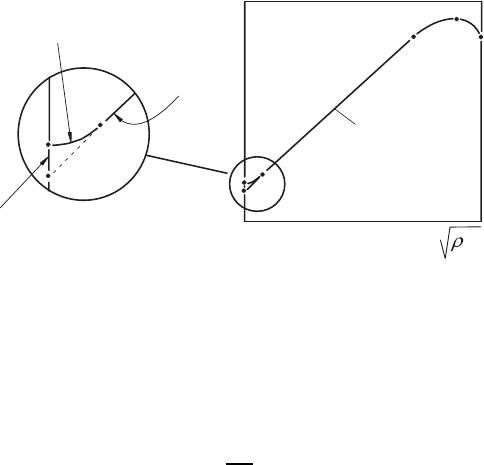
21.5 Basics of Hot-Wire Anemometry 681
Influence of free
convection
L
K
K
*
M
N
Q
E
2
U
E =A+BU
2
n
L
Convection
dominated range
Influence of free
convection
Fig. 21.24 Fundamental diagram of the calibration curve of a hot-wire probe
velocity. There is a non-linear dependence of the anemometer output voltage
on the flow velocity.
In order to study the heat transfer from hot-wire sensors over a wide
velocity range, i.e. from very low velocities up to high velocities, but Ma <
0, 3, the supplied electric energy, which is proportional to the square of the
voltage, is plotted as a function of
√
ρU (Norman, 1967). The reasons for this
type of plotting will be discussed later, but equation (21.24) already makes
clear the necessity for this type of functional behavior.
One can divide the calibration curve into sub-ranges which physically
obey different laws. The sub-range of the calibration curve between L and
M in Fig. 21.24 is important for air flows in practical flow cases. It can be
approximated analytically as follows:
E
2
= A + BU
n
(21.24)
This relationship is just a modification of King’s law for the heat loss from a
heated cylinder. One has thus taken over, for explaining Fig. 21.24, the funda-
mentally existing analytical function between the energy loss and the velocity
of King’s equation. The parameters A, B and n are determined by calibra-
tion, as all the assumptions made by King with regard to the properties of
sensors are not known in practice, or do not apply exactly. In the area L to M
in Fig. 21.24, A, B and n are almost constant, as results from measurements.
In the sub-range of the calibration curve between K and L free convection
dominates. With increasing flow velocity or, more precisely, with increasing
Mach number, the probe reaches its maximum cooling, and then decreases
with further increase of the Mach number. In the sub-range M–N –Q,itis
not possible to attribute only one velocity value to each measured value E,
i.e. the function in this area is not unique. In measuring practice the hot wire
is often employed only in the range L–M.
As the calibration of an employed hot-wire anemometer is every-day rou-
tine work for a flow-measurement technician, it is necessary to explain step
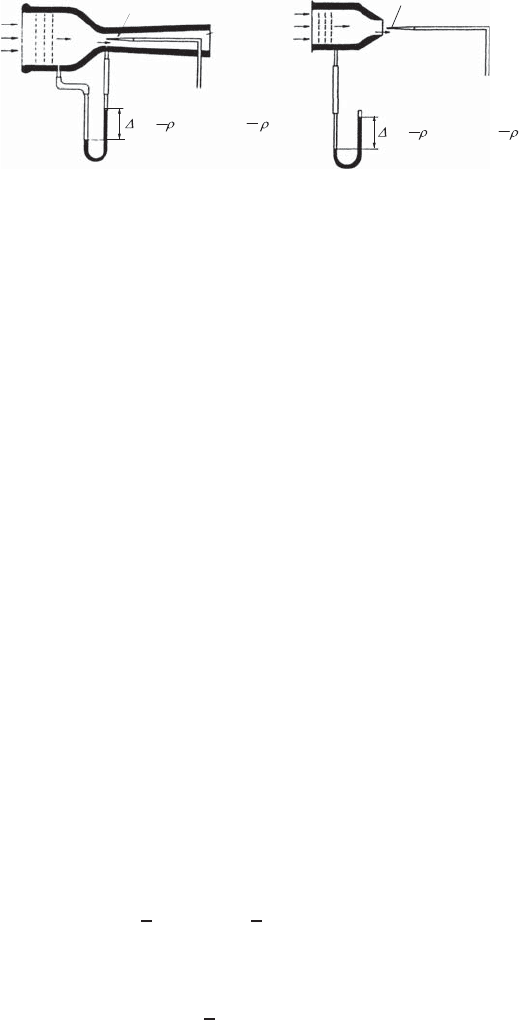
682 21 Introduction to Fluid-Flow Measurement
Sensor
Sensor
Pressure measurement
2
2
1
To anemometer
Calibration principle
U
U
1
U
1
U
P=
(U - U ) =
U
1
1
2
2
2
~
P=
(U - U ) =
U
1
2
1
2
1
2
2
2
~
Pressure measurement
Compressed air
To anemometer
Compressed air
Fig. 21.25 Calibration channels with mounted hot-wire probe and pressure
measuring device
by step how to proceed in calibrating a commercially available hot-wire
anemometer in an air jet. The probe is mounted, for the calibration, directly
in or shortly after the nozzle outlet of a calibration channel (Fig. 21.25). The
hot-wire sensor is oriented towards the outcoming flow. It is thus ensured
thattheprobeislocatedinanareaofuniformvelocityandlowturbulence
intensity. In this region, the geometry of the nozzle also defines the flow
direction.
The calibration of a hot wire is carried out for many velocity points over the
entire velocity range that is of interest for a particular set of measurements.
For flow velocities that are not too low and not too high, as mentioned above
the calibration follows a law as given by Fig. 21.24. Practical application of a
calibrated hot wire is often limited to the range where this simple analytical
expression for the E = f(U) dependence can be found, i.e. to the L–M range
in Fig. 21.24.
The following data serve as an example of a typical velocity calibration.
The room temperature for these measurements was t
Atm
=19.5
◦
Candthe
atmospheric pressure was p
Atm
= 756 mmHg.
The measured anemometer output voltages E and the pressure difference
read from the manometer and the atmospheric pressure, ∆p,aregiveninthe
first two lines of Table 21.2.
To evaluate the E
2
(U) relationship from the data given in Table 21.2,
the calibration velocity U has to be computed from the measured pressure
differences ∆p. Assuming an incompressible friction-free flow, the Bernoulli
theorem between the cross-sections in front of and directly behind the
calibration nozzle reads
ρ
2
U
2
1
+ p
1
=
ρ
2
U
2
+ p (21.25)
With p = p
Atm
and p
1
− p
Atm
= ∆p,oneobtains:
∆p =
ρ
2
!
U
2
− U
2
1
"
(21.26)

21.5 Basics of Hot-Wire Anemometry 683
Table 21.2 Typical data of a hot-wire calibration
Anemometer Nozzle pressure ∆p Calibration velocity E
2
U
0.4356
output at manometer (m s
−1
)
voltage (V) (mm W
−1
s
−1
) U = 1.2821
∆p (mm W
−1
s
−1
) × 9.8066
2.88 1.04 4.09 8.29 1.85
3.01 2.11 5.83 9.06 2.15
3.16 4.24 8.27 9.98 2.51
3.28 7.20 10.77 10.76 2.82
3.36 10.25 12.85 11.29 3.04
3.46 15.20 15.65 11.97 3.31
3.54 20.17 18.03 12.53 3.52
3.62 27.42 21.02 13.10 3.77
3.68 33.47 23.23 13.54 3.93
3.73 39.88 25.35 13.91 4.09
3.79 43.34 27.62 14.36 4.24
3.83 54.
53 29.65 14.67 4.38
3.90 67.26 32.93 15.21 4.58
When the area ratio of the nozzle inlet to the nozzle outlet is larger than
1:16, as in the present calibration, the velocity U
1
in the above equation
can be neglected without great loss of accuracy. Hence, one obtains for the
calibration velocity from the ∆p measurements:
U =
0
2
ρ
∆p (21.27)
The density of the air, which is not known yet, can be computed from the
law for ideal gases:
p = ρRT (21.28)
Under the calibration conditions mentioned here, ρ is given by:
ρ =
P
Atm
RT
Atm
=
756 × 133.3
283 (273 + 19.5)
=1.2167 N s
2
m
−4
(21.29)
!
with 133.3Nm
−2
/mmHg = 1; R
air
= 283 m
2
s
−2
K
−1
"
With this result, the calibration velocity can be computed:
U =1.2821
∆p , (21.30)
where
√
∆p represents the pressure difference read from the manome-
ter. In the above equation, ∆p has to be multiplied by 9.8066
(1 mm W s ˆ=9.8066 n m
−2
) and then only the root has to be extracted
and finally to be multiplied by 1.2821. In this way, one obtains the calibra-
tion velocities stated in the third column of Table 21.2. Figure 21.26 shows a
typical calibration curve of a hot-wire probe. It was obtained by plotting the
voltage measured at the anemometer outlet as a function of the computed
calibration velocities.
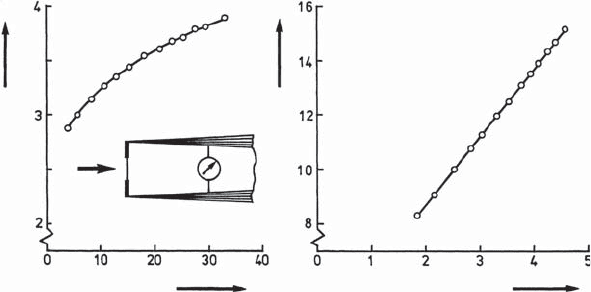
684 21 Introduction to Fluid-Flow Measurement
U
E
E =
3,6542
+
2,5147
U
E
2
0,4356
U
U
0,4356
[Volt]
[m/s]
Fig. 21.26 Calibration curve taken during calibration, in two manners of
representation
The application of hot-wire anemometers to determine the local velocity
of a fluid flow from voltage measurements, is occasionally helped by applying
an analytical expression for the voltage-velocity laws. As already mentioned,
in the velocity range investigated here, this law can be represented by the
modified King law:
E
2
= A + BU
n
(21.31)
The calibration task lies in the determination of the constants A, B and n
from the measured data. This can be done graphically, by plotting the square
of the anemometer output voltage against U
n
. However, the exponent n is not
known a priori, so that a variation of n is required, until the correct exponent
n yields the measurement points lying on a straight line. The exponent n
depends somewhat on the flow velocity; in a limited velocity range a constant
exponent n can be defined, however. The gradient of the straight line in the
E
2
− U
n
diagram corresponds to the constant B. The voltage value in the
point of intersection of the extrapolated straight line and the E axis provides
the constant A.
The values for the constants A, B, n can also be determined numerically.
In an iteration procedure, the exponent n is changed systematically, and for
each n value the other remaining constants A and B are evaluated from
the calibration data by applying the method of least-squares fit. When a
minimum of the “square of errors” between the analytical expression and the
calibration data is obtained, A, B and n are taken as best fits.
Finally it should be emphasized that the constant A does not agree with
the output voltage of the anemometer at zero velocity. This is understandable,
as two differing mechanisms of heat transfer define this quantity. In the case of
the E
2
measurement at U = 0, the heat release by free convection dominates
and in the case of extrapolation of the data to U = 0, the heat release is due
to forced convection.
